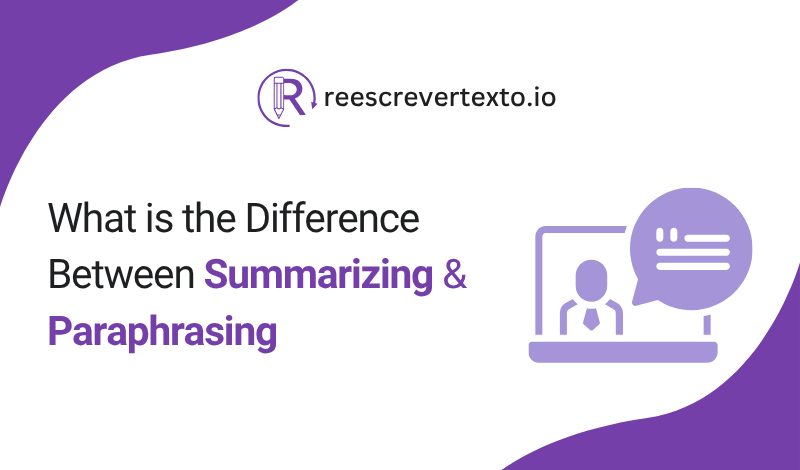
Do you want to rewrite someone’s idea without copying it word for word? You can either summarize or paraphrase the text. Many students confuse the two because they don’t know when to paraphrase and when to summarize.
Summarizing helps you shorten a long text, and paraphrasing helps you explain a specific point in your own words. You’ll use both in research, essays, and academic writing. In this blog, you’ll learn the clear difference between paraphrasing and summarizing, when to use each, and how to do them the right way.
What Is the Main Difference Between Summarizing and Paraphrasing?
Paraphrasing means writing someone else's perspective in your own words. You do it when you want to highlight a specific point from a source without quoting it directly. When you paraphrase text, you keep the original meaning and length, but rewrite it in your own style. That adds a natural flow to your writing and helps it sound original.
On the other hand, when you focus only on the key points instead of rewording every sentence, that’s called summarizing. A summary skips extra examples, detailed data, and side pointsYou can also use the rewrite text online tool to quickly improve clarity, fix grammar mistakes, and give your content a more polished tone.
In short, the core idea behind paraphrasing vs summarizing is that one keeps the length and detail, the other cuts it short. The difference between a summary and a paraphrase lies in their purpose and word count. If you're asking what the difference is between summarizing and paraphrasing, now you know: one condenses, the other rewords.
What Is the Strategy of Paraphrasing?
Paraphrasing requires more than just replacing words. You need to understand the original text and then rewrite it in your own words. That means reorganizing the sentence structure, using new words, and simplifying the ideas. You express the same message in your own writing style without changing the meaning.
Here are the steps of Paraphrasing:
Read a passage multiple times, then find the main argument and note important terms.
Find similar words that match the meaning and reshape the entire structure.
Mention the original author to respect their work.
Review your version next to the original to catch errors.
Fix anything unclear or too close to the source.
This technique enhances the effectiveness of the paraphrasing and summarizing process, particularly in academic papers. Many people compare summary vs paraphrasing, but forget both need clarity and originality. If you’re stuck on paraphrasing versus summarizing, just remember—one restates a point, the other simplifies the full idea.
How to Summarize?
Summarizing means writing the main message of the whole content. If you want to write a summary, you have to start with deep reading to pick all the main points. That way, you can write a useful summary. A summary helps the readers to grasp the message without wasting time. You can follow these steps to write a good summary:
Read the text, spot the main ideas, and highlight words or phrases that sum up each section.
Find the main idea of the content, its meaning, and purpose. You can skip details or numbers if they are not crucial.
Rewrite the author's ideas in your writing style, but make sure the meaning and tone remain the same as the original.
Use clear and simple sentences and avoid repetition or examples. Write your summary much shorter than the source.
Arrange points in the same order as the original and end by summing up the overall idea.
Review and check your summary to make sure it reflects the main message.
That method supports your work whether you’re learning to summarize meaning or want a better grasp of summarizing definitions. People often wonder what is summarizing, and that’s the basic answer—it condenses without losing the core idea.
Conclusion
Paraphrasing and summarizing both help you to reuse the information legally. It is like delivering information in your words, but you have to choose whether you need a restatement or a shorter version.
Paraphrasing brings out specific ideas with clarity.
Summarizing wraps up big concepts in fewer words.
You need to learn both because they are used when writing a paper or explaining sources.
In short, paraphrasing and summarizing both support you in building your voice.
When you think about paraphrasing vs summary, it’s less about choice and more about the writing goal. Many learners use paraphrasing vs summarizing in the wrong way. You don’t need to overthink it. Use a summary to give the big picture and paraphrase to expand a point.
FAQs
Can I paraphrase without citing?
No, you always need to cite the source, even if the wording is different. The idea still belongs to the original author.
How long should I write a summary?
A summary should be less than the original text. Your goal is to capture only the essential points.
What happens if I mix paraphrasing with copying?
That can lead to unintentional plagiarism. You need to fully rephrase and cite to stay safe.
Do summaries need citations too?
Yes, when the summary comes from someone else’s work. You still need to credit the source.
Is paraphrasing allowed in academic writing?
Yes, paraphrasing is allowed and encouraged in academic writing, but it's crucial to do it correctly by properly citing the source of the information.